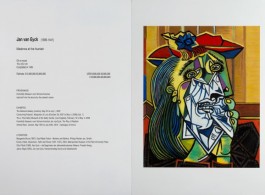“A Catalogue of Error”
May 19th – July 30th, 2016 / London
Opening on Thursday May 19th / 6 – 8 pm
Exhibited at Almine Rech gallery for the first time, Stephane Graff’s A Catalogue of Errors is an ongoing series begun in 2010, comprised of diptych panels that fuse text and painting.
Making reference to typical catalogue double-page spreads featuring a work of art to one side and its accompanying description on the other, the paintings here drift through space in pairs, with neither hierarchy nor chronology. Although, at first glance, we may focus on a work by Warhol, Duchamp, or even Picasso, reading the text on the left half nevertheless impedes our ability to instantly recognize the iconic language of the represented artist on the right.
Inspired by the sales catalogues produced by auction houses, most notably Sotheby’s and Christie’s, Stephane Graff offers us two individual artists’ imaginary lots, questioning the auction’s role in imposing a standardized system upon the art market. Responding to the personification of the artist that occurs through a reproduced image, Graff brings to light the interconnection between a name and the value a piece can command, the eclectic and repetitive nature of sales catalogues with their routine descriptions, page after page of paintings and sculptures, both figurative and abstract. Looking closely at Chagall/Richter, for instance, we are struck by how interchangeable the short description on the work can be. Graff’s careful selections demonstrate how these texts, while meant to improve our appreciation of a piece, might very well describe any other work of art, give or take a detail. Here, the “red flowers” are indeed in the picture, nevertheless, the artist’s humorous allusions lead us to a new, and entirely disorienting view of masterpieces, whether they be Marcel Duchamp’s readymades juxtaposed with Van Gogh’s nature morte, Fontana’s series of slashed monochrome paintings with Rembrandt’s Circumcision or Picasso’s Seated Woman paired with Warhol’s Electric Chair.
Through this strategy the artist questions the special relationship between an image and its origin, the subject and its representation. Ultimately, Graff’s Courbet/Fontana directs our attention to the sexual connotation of the slit and the raw eroticism of a subject, with Courbet’s work being an infamously controversial example. As the artist explains, “An ‘unseen’ element seems to exist between the left and the right halves of my work. Sometimes it can bewilder or puzzle. I’m striving to make the two halves connect, like synapses in the brain, impulses passing between two nerve cells,”1 referring to the brain function experiments carried out by his scientific alter ego, Professore. In the tradition of Kosuth and Magritte, Graff defies the literal definition attributed to things and their preconceived representations, thus recalibrating the encyclopedic nature of memory.
The use of oil paint to render photographs of sculptures by Degas, Rodin, and even Giacometti are pivotal for Graff, since, for him, the photographic backdrops and shadows cast on the ground become as technically crucial as the material used for the sculpture itself. It is through the pictorial reproduction of the photographic image, drawing from different materials and techniques, that Graff’s definition of his own style appears as equally intriguing as the aesthetic identity of the pantheon that he refers to. This return to the hand-made and its respect for the techniques specific to each painted work reminds us that a reproduction is inextricably tied to the aura and condition of an artwork.
Which is the original? Which is the copy? Where does authenticity lie? A Catalogue of Errors shuffles, like a deck of playing cards, our preconceptions, creating a museum more eccentric than imaginary, and substitutes the art market’s values with playfulness, free association, and creativity.
Self-taught artist and photographer Stephane Graff was born in the U.K in 1965, and lives and works in London. His previous bodies of work include Constrictions (1992), Black Box (1996) and Professore (2007). His work has been exhibited internationally since 1988 in institutions such as the Musée d’art Moderne et Contemporain in Nice, France (2013); the Ercel Foundation in Turin, Italy (2010); the Musée de Marrakech, Morocco (2004); and the Museum of Mankind in London, England (1991).
1 Interview with the artist in April 2016.



